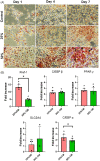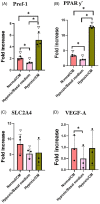Amniotic growth factors enhanced human pre-adipocyte cell viability and differentiation under hypoxia
- PMID: 35384274
- PMCID: PMC9283253
- DOI: 10.1002/jbm.b.35068
Amniotic growth factors enhanced human pre-adipocyte cell viability and differentiation under hypoxia
Abstract
One of the major drawbacks associated with autologous fat grafting is unpredictable graft retention. Various efforts to improve the survivability of these cells have been explored, but these methods are time-consuming, complex, and demand significant technical skill. In our study, we examine the use of cryopreserved amniotic membrane as a source of exogenous growth factors to improve adipocyte survivability under normal and hypoxic conditions. Human primary preadipocytes were cultured in a gelatin-ferulic acid (Gtn-FA) hydrogel with variable oxygen concentration and treated with amniotic membrane-derived condition medium (CM) for 7 days. This hydrogel provides a hypoxic environment and also creates a 3D cell culture to better mimic recipient site conditions. The O2 concentration in the hydrogel was measured by electron paramagnetic resonance oxygen imaging (EPROI). The conjugation of FA was confirmed by FTIR and NMR spectroscopy. The cell viability and adipocyte differentiation were analyzed by alamarBlue™ assay, Oil Red O staining, and RT-qPCR. The expression of genes: Pref-1, C/EBP β, C/EBP α, PPAR-ƴ, SLC2A4, and VEGF-A were quantified. The cell viability results show that the 50% CM showed significantly higher cell pre-adipocyte cell viability. In addition, compared to normal conditions, hypoxia/CM provided higher PPAR-ƴ (p < .05), SLC2A4, and VEGF-A (p < .05) (early and terminal differentiating markers) mRNA expression. This finding demonstrates the efficacy of amniotic CM supplementation as a novel way to promote adipocyte survival and retention via the expression of key gene markers for differentiation and angiogenesis.
Keywords: adipocytes; amniotic growth factors; fat grafting; hypoxia; synergism.
© 2022 The Authors. Journal of Biomedical Materials Research Part B: Applied Biomaterials published by Wiley Periodicals LLC.
Figures






Similar articles
-
Pref-1 in brown adipose tissue: specific involvement in brown adipocyte differentiation and regulatory role of C/EBPδ.Biochem J. 2012 May 1;443(3):799-810. doi: 10.1042/BJ20111714. Biochem J. 2012. PMID: 22324440
-
Connective tissue growth factor inhibits adipocyte differentiation.Am J Physiol Cell Physiol. 2008 Sep;295(3):C740-51. doi: 10.1152/ajpcell.00333.2007. Epub 2008 Jul 2. Am J Physiol Cell Physiol. 2008. PMID: 18596209
-
Anti-adipogenic action of pitavastatin occurs through the coordinate regulation of PPARgamma and Pref-1 expression.Br J Pharmacol. 2007 Jul;151(6):807-15. doi: 10.1038/sj.bjp.0707250. Epub 2007 Jun 4. Br J Pharmacol. 2007. PMID: 17549051 Free PMC article.
-
Molecular mechanisms of adipocyte differentiation and inhibitory action of pref-1.Crit Rev Eukaryot Gene Expr. 1997;7(4):281-98. doi: 10.1615/critreveukargeneexpr.v7.i4.10. Crit Rev Eukaryot Gene Expr. 1997. PMID: 9607168 Review.
-
Adipose Tissue Hypoxia in Obesity and Its Impact on Preadipocytes and Macrophages: Hypoxia Hypothesis.Adv Exp Med Biol. 2017;960:305-326. doi: 10.1007/978-3-319-48382-5_13. Adv Exp Med Biol. 2017. PMID: 28585205 Review.
Cited by
-
Oxygen Imaging of a Rabbit Tumor Using a Human-Sized Pulse Electron Paramagnetic Resonance Imager.Mol Imaging Biol. 2024 Jun;26(3):403-410. doi: 10.1007/s11307-023-01852-3. Epub 2023 Sep 15. Mol Imaging Biol. 2024. PMID: 37715089
-
Current Modalities in Soft-Tissue Reconstruction and Vascularized Adipose Engineering.Biomolecules. 2025 May 28;15(6):780. doi: 10.3390/biom15060780. Biomolecules. 2025. PMID: 40563421 Free PMC article. Review.
-
In Vivo Mouse Abdominal Oxygen Imaging And Assessment of Subcutaneously Implanted Beta Cell Replacement Devices.Mol Imaging Biol. 2025 Feb;27(1):64-77. doi: 10.1007/s11307-024-01963-5. Epub 2024 Dec 4. Mol Imaging Biol. 2025. PMID: 39633071
-
Survival Mechanisms and Retention Strategies in Large-Volume Fat Grafting: A Comprehensive Review and Future Perspectives.Aesthetic Plast Surg. 2024 Oct;48(20):4178-4193. doi: 10.1007/s00266-024-04338-x. Epub 2024 Aug 27. Aesthetic Plast Surg. 2024. PMID: 39191922 Review.
-
Electron Spin Resonance Probe Incorporation into Bioinks Permits Longitudinal Oxygen Imaging of Bioprinted Constructs.Mol Imaging Biol. 2024 Jun;26(3):511-524. doi: 10.1007/s11307-023-01871-0. Epub 2023 Dec 1. Mol Imaging Biol. 2024. PMID: 38038860 Free PMC article.
References
-
- Jeong JH. Recent advancements in autologous fat grafting. Arch Aesthetic Plast Surg. 2014;20(1):3‐7.
-
- Abboud MH, Dibo SA, Abboud NM. Power‐assisted liposuction and Lipofilling: techniques and experience in large‐volume fat grafting. Aesthet Surg J. 2020;40:180‐190. - PubMed
-
- Khouri RKJ, Khouri RK. Current clinical applications of fat grafting. Plast Reconstr Surg. 2017;140(3):466e‐486e. - PubMed
-
- Gutowski KA, ASPS Fat Graft Task Force . Current applications and safety of autologous fat grafts: a report of the ASPS fat graft task force. Plast Reconstr Surg. 2009;124(1):272‐280. - PubMed
-
- Bank J, Fuller S, Henry G, Zachary L. Fat grafting to the hand in patients with Raynaud phenomenon: a novel therapeutic modality. Plast Reconstr Surg. 2014;133(5):1109‐1118. - PubMed
Publication types
MeSH terms
Substances
Grants and funding
LinkOut - more resources
Full Text Sources

